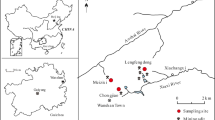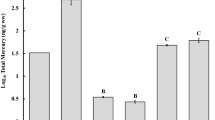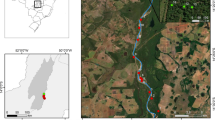Abstract
Mercury (Hg) methylation is often elevated at the terrestrial–peatland interface, but methylmercury (MeHg) production at this “hot spot” has not been linked with in situ biotic accumulation. We examined total Hg and MeHg levels in peat, invertebrates and tissues of the insectivore Sorex cinereus (masked shrew), inhabiting a terrestrial–peatland ecotone in northern Minnesota, USA. Mean MeHg concentrations in S. cinereus (71 ng g−1) fell between concentrations measured in spiders (mean 70–140 ng g−1), and ground beetles and millipedes (mean 29–42 ng g−1). Methylmercury concentrations in S. cinereus increased with age and differed among tissues, with highest concentrations in kidneys and muscle, followed by liver and brain. Nearly all Hg in S. cinereus was in the methylated form. Overall, the high proportional accumulation of MeHg in peat at the site (3.5% total Hg as MeHg) did not lead to particularly elevated concentrations in invertebrates or shrews, which are below values considered a toxicological risk.



Similar content being viewed by others
References
Bartrons M, Gratton C, Spiesman BJ, Vander Zanden MJ (2015) Taking the trophic bypass: aquatic-terrestrial linkage reduces methylmercury in a terrestrial food web. Ecol Appl 25:151–159
Batzer DP, Wu H, Wheeler T, Eggert SL (2016) Peatland invertebrates. In: Batzer DP, Boix D (eds) Invertebrates in freshwater wetlands: an international perspective on their ecology. Springer, New York, pp 219–250
Bellocq MI, Bendell JF, Duncan GLI (1994) Diet of Sorex-cinereus, the masked shrew, in relation to the abundance of lepidoptera larvae in northern Ontario. Am Midl Nat 132:68–73. doi:10.2307/2426201
Bloom N (1989) Determination of picogram levels of methylmercury by aqueous phase ethylation, followed by cryogenic gas-chromatography with cold vapor atomic fluorescence detection. Can J Fish Aquat Sci 46:1131–1140. doi:10.1139/f89-147
Blossom PM (1932) A pair of long-tailed shrews (Sorex cinereus cinereus) in captivity. J Mammal 13:136–143. doi:10.2307/1374050
Branfireun BA, Heyes A, Roulet NT (1996) The hydrology and methylmercury dynamics of a Precambrian Shield headwater peatland. Water Resour Res 32:1785–1794. doi:10.1029/96WR00790
CCME (2000) Canadian tissue residue guidelines for the protection of wildlife consumers of aquatic biota—Methylmercury. In: Canadian environmental quality guidelines. Canadian Council of Ministers of the Environment, Winnipeg
Coleman Wasik JK, Mitchell CPJ, Engstrom DR, Swain EB, Monson BA, Balogh SJ, Jeremiason JD, Branfireun BA, Eggert SL, Kolka RK, Almendinger JE (2012) Methylmercury declines in a boreal peatland when experimental sulfate deposition decreases. Environ Sci Technol 46:6663–6671. doi:10.1021/es300865f
Coleman Wasik JK, Engstrom DR, Mitchell CPJ, Swain EB, Monson BA, Balogh SJ, Jeremiason JD, Branfireun BA, Kolka RK, Almendinger JE (2015) The effects of hydrologic fluctuation and sulfate regeneration on mercury cycling in an experimental peatland. J Geophys Res Biogeosci 120:1697–1715. doi:10.1002/2015JG002993
Cristol DA, Brasso RL, Condon AM, Fovargue RE, Friedman SL, Hallinger KK, Monroe AP, White AE (2008) The movement of aquatic mercury through terrestrial food webs. Science 320:335–335. doi:10.1126/science.1154082
Eagles-Smith CA, Wiener JG, Eckley CS, Willacker JJ, Evers DC, Marvin-DiPasquale M, Obrist D, Fleck JA, Aiken GR, Lepak JM, Jackson AK, Webster JP, Stewart AR, Davis JA, Alpers CN, Ackerman JT (2016) Mercury in western North America: a synthesis of environmental contamination, fluxes, bioaccumulation, and risk to fish and wildlife. Sci Total Environ 568:1213–1226. doi:10.1016/j.scitotenv.2016.05.094
Edgar WD (1969) Prey and predators of the wolf spider Lycosa lugubris. J Zool 159:405–411
Gann GL, Powell CH, Chumchal MM, Drenner RW (2015) Hg-contaminated terrestrial spiders pose a potential risk to songbirds at Caddo Lake (Texas/Louisiana, USA). Environ Toxicol Chem 34:303–306. doi:10.1111/j.1469-7998.1969.tb03897.x
Gerstenberger SL, Cross CL, Divine DD, Gulmatico DD, Rothweiler AM (2006) Assessment of mercury concentrations in small mammals collected near Las Vegas, Nevada, USA. Environ Toxicol 21:583–589. doi:10.1002/tox.20221
Gilmour CC, Podar M, Bullock AL, Graham AM, Brown SD, Somenahally AC, Johs A, Hurt RA Jr, Bailey KL, Elias DA (2013) Mercury methylation by novel microorganisms from new environments. Environ Sci Technol 47:11810–11820. doi:10.1021/es403075t
Haynes KM, Mitchell CPJ (2012) Inter-annual and spatial variability in hillslope runoff and mercury flux during spring snowmelt. J Environ Monit 14:2083–2091. doi:10.1039/c2em30267e
Hintelmann H, Ogrinc N (2003) Determination of stable mercury isotopes by ICP/MS and their application in environmental studies. ACS Symp Ser 835:321–338
Hsu-Kim H, Kucharzyk KH, Zhang T, Deshusses MA (2013) Mechanisms regulating mercury bioavailability for methylating microorganisms in the aquatic environment: a critical review. Environ Sci Technol 47:2441–2456. doi:10.1021/es304370g
Kolka RK, Mitchell CPJ, Jeremiason JD, Hines NA, Grigal DF, Engstrom DR, Coleman-Wasik JK, Nater EA, Swain EB, Monson BA, Fleck JA, Johnson B, Almendinger JE, Branfireun BA, Brezonik PL, Cotner JB (2011) Mercury cycling in peatland watersheds. In: Kolka RK, Sebestyen SD, Verry ES, Brooks KN (eds) Peatland biogeochemistry and watershed hydrology at the Marcell Experimental Forest. CRC Press, Boca Raton, pp 349–370
Kwon SY, Blum JD, Nadelhoffer KJ, Dvonch JT, Tsui MTK (2015) Isotopic study of mercury sources and transfer between a freshwater lake and adjacent forest food web. Environ Sci Technol 532:220–229
McCay TS, Storm GL (1997) Masked shrew (Sorex cinereus) abundance, diet and prey selection in an irrigated forest. Am Midl Nat 138:268–275. doi:10.2307/2426820
Mitchell CPJ, Branfireun BA, Kolka RK (2008) Spatial characteristics of net methylmercury production hot spots in peatlands. Environ Sci Technol 42:1010–1016. doi:10.1021/es0704986
Nordquist GE (1992) Small mammals. In: Wright HE Jr, Coffin BA, Aaseng NE (eds) The patterned peatlands of minnesota. University of Minnesota Press, Minneapolis, pp 85–110
Oswald CJ, Heyes A, Branfireun BA (2014) Fate and transport of ambient mercury and applied mercury isotope in terrestrial upland soils: insights from the METAALICUS watershed. Environ Sci Technol 48:1023–1031. doi:10.1021/es404260f
Petkovsek SA, Kopusar N, Krystufek B (2014) Small mammals as biomonitors of metal pollution: a case study in Slovenia. Environ Monit Assess 186:4261–4274. doi:10.1007/s10661-014-3696-7
Rieder SR, Brunner I, Horvat M, Jacobs A, Frey B (2011) Accumulation of mercury and methylmercury by mushrooms and earthworms from forest soils. Environ Pollut 159:2861–2869
Rimmer CC, Miller EK, McFarland KP, Taylor RJ, Faccio SD (2010) Mercury bioaccumulation and trophic transfer in the terrestrial food web of a montane forest. Ecotoxicology 19:697–709
RStudio Team (2016) RStudio: integrated development for R. RStudio, Inc., Boston. http://www.rstudio.com
Rudd R (1955) Age, sex, and weight comparisons in three species of shrews. J Mammal 36:323–339. doi:10.2307/1375674
Ryan JM (1986) Dietary overlap in sympatric populations of Pygmy shrews, Sorex hoyi, and Masked shrews, Sorex cinereus, in Michigan. Can Field-Nat 100:225–228
Sánchez-Chardi A, Lopez-Fuster MJ, Nadal J (2007) Bioaccumulation of lead, mercury, and cadmium in the greater white-toothed shrew, Crocidura russula, from the Ebro Delta (NE Spain): sex-and age-dependent variation. Environ Pollut 145:7–14. doi:10.1016/j.envpol.2006.02.033
Sánchez-Chardi A, Ribeiro CAO, Nadal J (2009) Metals in liver and kidneys and the effects of chronic exposure to pyrite mine pollution in the shrew Crocidura russula inhabiting the protected wetland of Donana. Chemosphere 76:387–394. doi:10.1016/j.chemosphere.2009.03.036
Scheuhammer AM, Meyer MW, Sandheinrich MB, Murray MW (2007) Effects of environmental methylmercury on the health of wild birds, mammals, and fish. Ambio 36:12–18
Schroeder WH, Munthe J (1998) Atmospheric mercury—an overview. Atmos Environ 32:809–822. doi:10.1016/S1352-2310(97)00293-8
Sebestyen SD, Dorrance C, Olson DM, Verry ES, Kolka RK, Elling AE, Kyllander R (2011) Long-term monitoring sites and trends at the Marcell Experimental Forest. In: Kolka RK, Sebestyen SD, Verry ES, Brooks KN (eds) Peatland biogeochemistry and watershed hydrology at the Marcell Experimental Forest. CRC Press, Boca Raton, pp 15–71
Speir SL, Chumchal MM, Drenner RW, Cocke WG, Lewis ME, Whitt HJ (2014) Methyl mercury and stable isotopes of nitrogen reveal that a terrestrial spider has a diet of emergent aquatic insects. Environ Toxicol Chem 33:2506–2509
Strickman RJS, Fulthorpe RR, Wasik JKC, Engstrom DR, Mitchell CPJ (2016) Experimental sulfate amendment alters peatland bacterial community structure. Sci Total Environ 566:1289–1296. doi:10.1016/j.scitotenv.2016.05.189
Talmage SS, Walton BT (1991) Small mammals as monitors of environmental contaminants. Rev Environ Contam Toxicol 119:47–108. doi:10.1007/978-1-4612-3078-6_2
Tjerngren I, Karlsson T, Bjorn E, Skyllberg U (2012) Potential Hg methylation and MeHg demethylation rates related to the nutrient status of different boreal wetlands. Biogeochemistry 108:335–350. doi:10.1007/s10533-011-9603-1
US Environmental Protection Agency (2002) Method 1631, Revision E: mercury in water by oxidation, purge and trap, and cold vapor atomic fluorescence spectrometry. US Environmental Protection Agency Office of Water, Washington
Whitaker JO (2004) Sorex cinereus. Mamm Species 743:1–9
Whitaker JO, Schmeltz LL (1973) Food and external parasites of Sorex-palustris and food of Sorex cinereus from St-Louis County, Minnesota. J Mammal 54:283–285. doi:10.2307/1378897
Wren C, MacCrimmon H, Frank R, Suda P (1980) Total and methylmercury levels in wild mammals from the Precambrian Shield area of south central Ontario, Canada. Bull Environ Contam Toxicol 25:100–105. doi:10.1007/BF01985495
Wyman KE, Rodenhouse NL, Bank MS (2011) Mercury bioaccumulation, speciation, and influence on web structure in orb-weaving spiders from a forested watershed. Environ Toxicol Chem 30:1873–1878
Acknowledgements
We thank Planck Huang for his help with lab analysis and staff at the Marcell Experimental Forest Research Station and the USFS Northern Research Station. Funding was provided by a NSERC Discovery grant and a Great Lakes Air Deposition Program grant to CPJM. Rachel Strickman and Planck Huang provided useful comments on the manuscript.
Author information
Authors and Affiliations
Corresponding author
Ethics declarations
Ethical Approval
All applicable international, national, and/or institutional guidelines for the care and use of animals were followed. All procedures and protocols were approved by the University of Toronto-Scarborough’s Animal Care Committee.
Rights and permissions
About this article
Cite this article
Tavshunsky, I., Eggert, S.L. & Mitchell, C.P.J. Accumulation of Methylmercury in Invertebrates and Masked Shrews (Sorex cinereus) at an Upland Forest–Peatland Interface in Northern Minnesota, USA. Bull Environ Contam Toxicol 99, 673–678 (2017). https://doi.org/10.1007/s00128-017-2198-z
Received:
Accepted:
Published:
Issue Date:
DOI: https://doi.org/10.1007/s00128-017-2198-z




